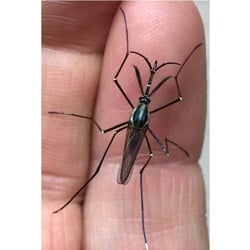Exploring Mosquito Species: The Elephant Mosquito
“Massive” and “giant” are not terms most of our partners want to hear associated with insects, especially mosquitoes, in their community. Toxorhynchites rutilus is the largest mosquito in the USA. An adult female can have a wing span of nearly ½ inch, and if it sat on a quarter, the tips of their long legs could dangle off the edges. Yeah, I’d call that massive.
 But fear not – these giant, day-flying mosquitoes do not need a blood meal to produce eggs, so they do not bite. Due to their lack of interest in taking a nibble, they are only caught in certain kinds of traps associated with mosquito surveillance, and cause little concern in the field of mosquito control. Both adult males and females feed exclusively on sugary substances – primarily flower nectar but also plant sap, honeydew, and juices from rotting fruit. They are sometimes called “elephant mosquitoes” due to their long, trunk-like proboscis that curves downward and is pointed at the tip to assist in sucking nectar from deep flowers. Since they don’t bite, they also don’t transmit any vector-borne diseases. Whew!
But fear not – these giant, day-flying mosquitoes do not need a blood meal to produce eggs, so they do not bite. Due to their lack of interest in taking a nibble, they are only caught in certain kinds of traps associated with mosquito surveillance, and cause little concern in the field of mosquito control. Both adult males and females feed exclusively on sugary substances – primarily flower nectar but also plant sap, honeydew, and juices from rotting fruit. They are sometimes called “elephant mosquitoes” due to their long, trunk-like proboscis that curves downward and is pointed at the tip to assist in sucking nectar from deep flowers. Since they don’t bite, they also don’t transmit any vector-borne diseases. Whew!
Toxorhynchites rutilus is also one of the most colorful mosquitoes in the USA. The body is covered with shiny, metallic, dark-blue scales, with patches of iridescent silvery-white, purple, and green scales ornamenting the sides of the thorax and abdomen. They are stunning, beautiful, and just down-right gorgeous.
The species is not common, but widely distributed throughout the southeastern USA, as far north as the Great Lakes, and west into Kansas, Oklahoma, and Texas. In warmer southern states, adults can be found nearly year-round, while in the north they overwinter as larvae.
Adult females lay bright-white eggs directly on the water surface in small containers, especially tree holes, pitcher plants, rock pools, and bromeliads, but additional larval habitats can also include man-made containers such as tires, bird baths, and flower pots.
The larvae are also much larger than other mosquito larvae, and quite colorful – a deep reddish color on the back, and greyish on the underside.
Most mosquito larvae filter bacteria and algae from water for food, but not these giants. Also known as “mosquito-eaters” or “cannibal mosquitoes,” they are predators on other mosquitoes and occasionally on each other. Their mandibles are unusually stout with comb-like extensions used for grasping prey. Because the larvae feed on other mosquito larvae, some attempts have been made to introduce various species of Toxorhynchites as biological control agents, but with only limited success.
Big, beautiful, and beneficial – these harmless mosquitoes should be regarded as an exception for anyone who believes that the only good mosquito is a dead mosquito.
Contact Us to Learn More About Effective Mosquito Management Strategies:
 Since 1992, Vector Disease Control International (VDCI) has taken pride in providing municipalities, mosquito abatement districts, industrial sites, planned communities, homeowners associations, and golf courses with the tools they need to run effective mosquito control programs. We are determined to protect the public health of the communities in which we operate. Our mosquito control professionals have over 100 years of combined experience in the field of public health, specifically vector disease control. We strive to provide the most effective and scientifically sound mosquito surveillance and control programs possible based on an Integrated Mosquito Management approach recommended by the American Mosquito Control Association (AMCA) and Centers for Disease Control and Prevention (CDC). VDCI is the only company in the country that can manage all aspects of an integrated mosquito management program, from surveillance to disease testing to aerial application in emergency situations.
Since 1992, Vector Disease Control International (VDCI) has taken pride in providing municipalities, mosquito abatement districts, industrial sites, planned communities, homeowners associations, and golf courses with the tools they need to run effective mosquito control programs. We are determined to protect the public health of the communities in which we operate. Our mosquito control professionals have over 100 years of combined experience in the field of public health, specifically vector disease control. We strive to provide the most effective and scientifically sound mosquito surveillance and control programs possible based on an Integrated Mosquito Management approach recommended by the American Mosquito Control Association (AMCA) and Centers for Disease Control and Prevention (CDC). VDCI is the only company in the country that can manage all aspects of an integrated mosquito management program, from surveillance to disease testing to aerial application in emergency situations.

